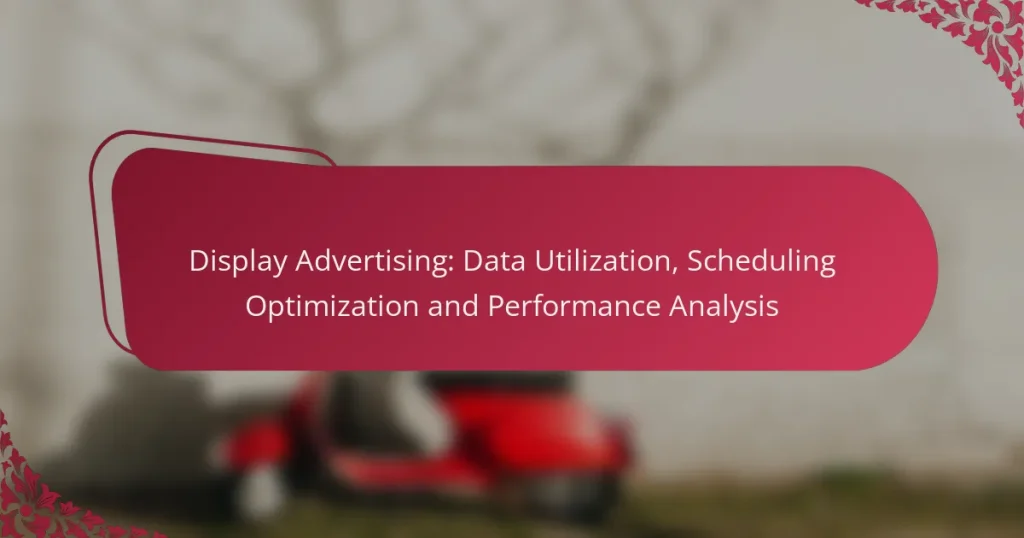Display advertising has evolved into a data-driven landscape where effective utilization of user insights can significantly enhance campaign performance. By leveraging data analytics, advertisers can tailor their strategies to specific audiences, optimize ad scheduling for maximum engagement, and conduct thorough performance analysis to refine their approaches. Understanding key metrics such as click-through rates and conversion rates is essential for measuring success and driving continuous improvement in advertising efforts.

How can data utilization enhance display advertising effectiveness?
Data utilization can significantly enhance display advertising effectiveness by enabling targeted strategies that resonate with specific audiences. By analyzing user behavior and preferences, advertisers can optimize their campaigns for better engagement and conversion rates.
Targeted audience segmentation
Targeted audience segmentation involves dividing a broad audience into smaller, more defined groups based on shared characteristics. This can include demographics, interests, and online behaviors, allowing advertisers to tailor their messages to specific segments. For example, a fashion retailer might target young adults with ads for trendy clothing while promoting formal wear to professionals.
Effective segmentation increases the relevance of ads, leading to higher click-through rates and conversions. Advertisers should regularly review and adjust their segments based on performance data to ensure optimal targeting.
Real-time performance tracking
Real-time performance tracking allows advertisers to monitor the effectiveness of their display ads as they run. By analyzing metrics such as impressions, clicks, and conversions in real time, advertisers can quickly identify which ads are performing well and which are not. This immediate feedback loop enables timely adjustments to campaigns, such as reallocating budget to high-performing ads or pausing underperforming ones.
Utilizing tools that provide real-time analytics can help streamline this process. Advertisers should focus on key performance indicators (KPIs) relevant to their goals, such as return on ad spend (ROAS) or cost per acquisition (CPA).
Predictive analytics for ad placements
Predictive analytics involves using historical data and statistical algorithms to forecast future outcomes, particularly in ad placements. By analyzing past performance data, advertisers can predict which placements are likely to yield the best results. This approach helps in making informed decisions about where and when to display ads for maximum impact.
For instance, if data shows that ads placed on specific websites during certain times of the day perform better, advertisers can prioritize those placements in their strategy. Implementing predictive models can enhance budget allocation and improve overall campaign efficiency.

What are the best practices for scheduling display ads?
To effectively schedule display ads, focus on timing, audience engagement, and strategic frequency. Implementing best practices can enhance visibility and improve overall campaign performance.
Peak engagement times
Identifying peak engagement times is crucial for maximizing the impact of display ads. Analyze historical data to determine when your target audience is most active online, typically during evenings and weekends for consumer products.
Consider using tools like Google Analytics to track user behavior and adjust your ad schedule accordingly. For example, if data shows higher engagement on Wednesdays from 6 PM to 9 PM, prioritize ad placements during these hours.
Frequency capping strategies
Frequency capping helps prevent ad fatigue by limiting the number of times a user sees the same ad. A common strategy is to cap impressions at around 3-5 times per week per user, ensuring your message remains fresh.
Utilize programmatic advertising platforms to set frequency caps effectively. Monitor performance metrics to adjust these limits based on user response, aiming for a balance between visibility and annoyance.
Seasonal campaign adjustments
Seasonal adjustments are essential for aligning your display ads with consumer behavior changes throughout the year. For instance, increase ad spend and frequency during holidays or major sales events when consumer interest peaks.
Plan campaigns in advance, taking into account seasonal trends and local events. For example, in the U.S., ramp up advertising efforts around Black Friday and Cyber Monday to capture increased shopping activity.

How to analyze performance metrics in display advertising?
Analyzing performance metrics in display advertising involves evaluating various indicators to understand the effectiveness of ad campaigns. Key metrics such as click-through rates, conversion rates, and return on ad spend provide insights into how well ads are performing and where improvements can be made.
Key performance indicators (KPIs)
Key performance indicators (KPIs) are essential metrics that help gauge the success of display advertising campaigns. Common KPIs include click-through rate (CTR), conversion rate, cost per acquisition (CPA), and return on investment (ROI). Tracking these metrics allows advertisers to assess which ads are resonating with their audience and driving desired actions.
For instance, a CTR of 1-2% is generally considered average for display ads, while a conversion rate of 2-5% is often seen as successful. Regularly monitoring these KPIs can help identify trends and inform strategic adjustments.
Conversion tracking methods
Conversion tracking methods are techniques used to measure the effectiveness of display ads in driving user actions, such as purchases or sign-ups. Common methods include using tracking pixels, UTM parameters, and conversion tags. These tools help attribute conversions directly to specific ads and campaigns.
Implementing tracking pixels on your website can provide real-time data on user interactions, while UTM parameters allow for detailed campaign analysis in analytics platforms. Ensuring proper setup is crucial for accurate data collection and analysis.
Attribution models for ad success
Attribution models determine how credit for conversions is assigned to various touchpoints in the customer journey. Common models include last-click, first-click, and multi-touch attribution. Each model offers different insights into which ads or channels are most effective in driving conversions.
For example, last-click attribution gives full credit to the final ad clicked before conversion, while multi-touch attribution distributes credit across all interactions. Choosing the right model depends on campaign goals and the complexity of the customer journey, and can significantly impact advertising strategy and budget allocation.

What tools can optimize display advertising campaigns?
Several tools can significantly enhance the effectiveness of display advertising campaigns by improving management, targeting, and performance analysis. Utilizing these tools helps advertisers maximize their return on investment and reach their desired audience more effectively.
Google Ads for display management
Google Ads is a powerful platform for managing display advertising campaigns, offering extensive reach across millions of websites and apps. Advertisers can create visually appealing ads and target specific demographics, interests, and behaviors, ensuring their messages reach the right audience.
To optimize campaigns, regularly monitor performance metrics such as click-through rates (CTR) and conversion rates. Adjusting bids and targeting settings based on this data can lead to improved campaign outcomes. Consider using automated bidding strategies to maximize results while minimizing manual effort.
AdRoll for retargeting
AdRoll specializes in retargeting, allowing advertisers to reconnect with users who have previously interacted with their brand. This tool helps keep the brand top-of-mind and encourages potential customers to return and complete their purchases.
To effectively use AdRoll, segment your audience based on their previous interactions and tailor your ads accordingly. Utilize dynamic ads that showcase products users have viewed to increase relevance and engagement. Regularly analyze performance data to refine your retargeting strategies.
Facebook Ads for audience reach
Facebook Ads provides robust targeting options, making it an excellent choice for reaching specific audiences through display advertising. Advertisers can leverage user data to create highly personalized ads that resonate with potential customers.
When using Facebook Ads, consider A/B testing different ad formats and messages to determine what works best for your audience. Monitor engagement metrics and adjust your targeting to optimize reach and effectiveness. Keep in mind that Facebook’s advertising policies must be adhered to, ensuring compliance with their guidelines.

What criteria should be considered when selecting display ad platforms?
When selecting display ad platforms, consider factors such as audience reach, targeting options, cost structures, and integration capabilities with analytics tools. These criteria will help ensure that your advertising efforts are effective and aligned with your marketing goals.
Audience reach and targeting options
Audience reach refers to the number of potential customers that a display ad platform can connect you with. Look for platforms that offer robust targeting options, such as demographic, geographic, and behavioral targeting, to ensure your ads reach the right audience.
For example, platforms like Google Display Network allow advertisers to target specific interests or behaviors, which can significantly enhance the effectiveness of your campaigns. Evaluate the platform’s reach in your target market to maximize visibility.
Cost-per-click vs. cost-per-impression
Understanding the difference between cost-per-click (CPC) and cost-per-impression (CPM) is crucial for budgeting your display advertising. CPC charges you only when a user clicks on your ad, while CPM charges you based on the number of times your ad is shown, regardless of clicks.
Choose CPC if your goal is to drive traffic to your website, as it can yield a higher return on investment. On the other hand, CPM might be more suitable for brand awareness campaigns where visibility is the primary objective.
Integration capabilities with analytics tools
Integration with analytics tools is essential for tracking the performance of your display ads. Platforms that seamlessly connect with tools like Google Analytics allow you to monitor key metrics, such as click-through rates and conversion rates, providing insights into campaign effectiveness.
Ensure that the platform you choose supports these integrations to facilitate data analysis and reporting. This capability will enable you to make informed decisions and optimize your advertising strategies based on real-time data.

What emerging trends are shaping the future of display advertising?
Emerging trends in display advertising are primarily driven by advancements in technology, particularly artificial intelligence, and evolving consumer behaviors. These trends include enhanced targeting capabilities, improved personalization, and the integration of data analytics for better performance measurement.
Artificial intelligence in ad targeting
Artificial intelligence (AI) is revolutionizing ad targeting by enabling advertisers to analyze vast amounts of data quickly and accurately. AI algorithms can identify patterns in consumer behavior, allowing for more precise audience segmentation and personalized ad delivery.
For instance, machine learning models can predict which users are most likely to engage with specific ads based on their past interactions. This results in higher conversion rates and more efficient ad spend. Advertisers should consider using AI tools that offer real-time optimization to adjust campaigns based on performance metrics.
However, relying solely on AI can lead to pitfalls, such as over-targeting or missing out on broader audience segments. A balanced approach that combines AI insights with human creativity and intuition is essential for effective display advertising strategies.

